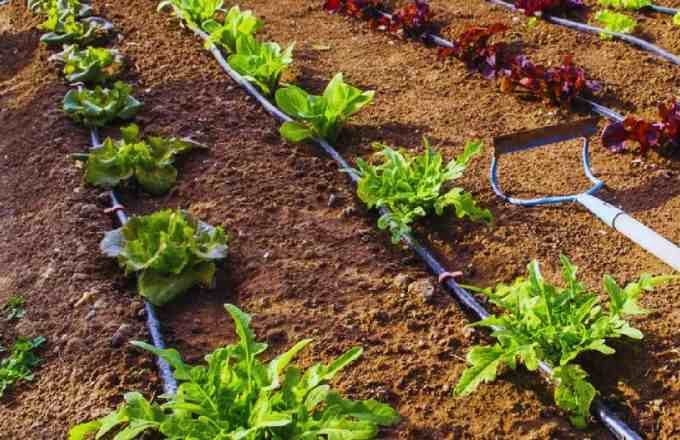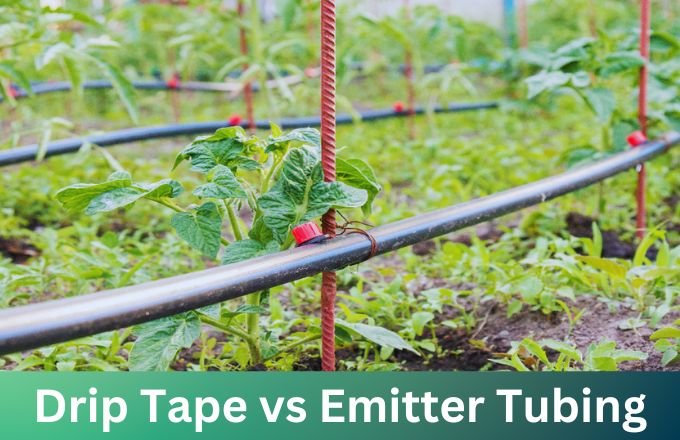Introduction
Irrigation is the lifeblood of any lush, flourishing garden. This article delves deep into two popular irrigation methods – drip irrigation vs soaker hose, guiding you through their unique features, applications, and benefits. By the end of this newsletter, you may have the expertise needed to select an appropriate watering device for your plants.
Table of Contents
Definition of Drip Irrigation

Drip irrigation is a high-efficiency watering system that delivers water directly to the base of each plant through a network of tubing and emitters. It’s a water-conservative method widely acclaimed for its precise water delivery, minimizing water wastage and ensuring optimal plant growth.
Definition of Soaker Hose
A soaker hose, on the other hand, is a porous hose that allows water to seep out slowly, delivering moisture directly to the plant’s roots. For gardeners seeking an inexpensive, user-pleasant watering choice, that is an extraordinary desire.

Drip Irrigation vs Soaker Hose: A Comparison
Efficiency and Water Conservation
drip irrigation vs soaker hose Drip irrigation stands out for its unparalleled efficiency and water conservation, making it the go-to choice for arid regions and areas with water restrictions. Soaker hoses, although not as precise, are still highly efficient and a favourite among home gardeners for their simplicity and affordability.
Suitability for Different Plants
Drip systems are versatile, catering to a wide range of plants, from vegetables and flowers to shrubs and trees. Soaker hoses excel in uniformly watering rows of plants, making them ideal for gardens with similar plant types and watering needs.
Installation and Maintenance
Installing a drip irrigation system can be intricate, requiring careful planning, and might necessitate professional help. Regular maintenance is crucial to avoid clogging and ensure longevity. Soaker hoses are more user-friendly, with simpler installation and minimal maintenance, making them a practical option for small-scale gardeners.
Cost Comparison
While drip systems might entail higher upfront costs and maintenance, their precision and water conservation make them a worthy investment in the long run. Soaker hoses are economical, offering a budget-friendly alternative for garden enthusiasts.
Key Features
- Easy Setup: Lay the hose for your garden, connect it to a water supply, and let it do its process.
- Cost-Effective: Soaker hoses are usually more budget-friendly compared to drip irrigation systems.
- Event Coverage: Provides even moisture distribution to a broader area.
- Low Maintenance: Requires minimal attention once set up.
In-depth into Drip Irrigation Systems
Components of Drip Irrigation
Drip irrigation systems are composed of a water source, filter, pressure regulator, mainline, sub-main, and emitters. Each element plays a pivotal position in ensuring the effective and clean functioning of the machine.
Benefits of Drip Irrigation
Drip irrigation offers a plethora of benefits, including precise water application, reduced water usage, minimized weed growth, and optimal soil moisture levels, fostering a conducive environment for plant growth.
Limitations and Challenges
Despite its myriad advantages, drip irrigation has its share of limitations, such as susceptibility to clogging, requiring meticulous maintenance, and higher initial investment.
Unraveling the World of Soaker Hoses
The Anatomy of Soaker Hoses
Soaker hoses are designed with absorbent materials, allowing water to ooze out gradually. Ensures a steady and uniform watering pattern, ideal for maintaining consistent soil moisture levels.
Benefits of Using Soaker Hoses
Soaker hoses are celebrated for their simplicity, cost-effectiveness, and ability to maintain optimal soil moisture, promoting healthy root development and reducing water wastage.
Drawbacks of Soaker Hoses
The limitations of soaker hoses include potential overwatering, reduced precision in water delivery, and susceptibility to UV damage, necessitating proper storage and care.
Drip Tape vs Drip Line: An Analysis
Distinctions between Drip Tape and Drip Line
While both are components of drip irrigation, drip tape is thinner, flexible, and suitable for seasonal crops. In contrast, the drip line is more durable and designed for perennial plants and landscapes.
Efficiency Analysis
A comparative analysis reveals that while both are efficient, the choice between drip tape and drip line depends largely on the type of plants, their water needs, and the intended duration of use.
Drip Tape vs. Emitter Tubing

Defining Characteristics
Emitter tubing and drip tape have distinct features, with the former being versatile and adaptable and the latter being more specialized and ideal for specific agricultural applications.
Optimal Use Cases
Emitter tubing is preferable in varied landscapes due to its flexibility. At the same time, drip tape excels in agricultural settings, offering precise watering for row crops.
Is a Soaker Hose Drip Irrigation?
Though a soaker hose has some commonalities with drip irrigation, like direct water delivery to roots, it doesn’t offer the precision and control of a drip system, classifying it as a distinct, simpler irrigation method.
Conclusive Thoughts on Irrigation Methods
The choice between drip irrigation an soaker hose hinges on your specific gardening needs, budget, and preferences. While drip systems offer precision and control, suitable for diverse landscapes, soaker hoses provide simplicity and affordability, ideal for uniform gardens.
Recommendations and Best Practices
For gardeners seeking optimal results, integrating both drip irrigation vs soaker hoses can offer a harmonious blend of precision and simplicity, ensuring your plants receive the ideal amount of water they need to thrive.
| Pros: | Cons: |
|---|---|
| Water Efficiency: Drip irrigation minimizes water wastage by delivering water right to the root zone. | Initial Setup: Installation may be more complex compared to soaker hoses. |
| Customizable: You can adjust the flow rate and placement of emitters for each plant’s specific needs. | Cost: The initial investment in drip irrigation systems can be higher. |
| Consistent Moisture: Provides a consistent level of moisture, preventing over or under-watering. | |
| Reduced Weed Growth: As water is targeted at plant roots, it discourages weed growth. |
Conclusion
Whether you choose drip irrigation vs soaker hose drip irrigation for its precision and versatility or soaker hose for its simplicity and cost-effectiveness, understanding your gardening needs and preferences is key. And sometimes, a combination of both might be the perfect concoction for a thriving garden. Happy Gardening!
Frequently ASK Question (FAQ)
Q: Can I use a soaker hose for my vegetable garden?
Absolutely! Soaker hoses are excellent for vegetable gardens, especially for rows of plants with similar water needs.
Q: Is drip irrigation suitable for all types of plants?
Drip irrigation is versatile and can cater to a wide range of plants, from delicate flowers to robust trees, making it suitable for diverse gardening needs.
Q: How often should I maintain my drip irrigation system?
Regular maintenance, including periodic checks for clogs and leaks, is crucial. Depending on your system and water quality, monthly to quarterly maintenance is usually adequate.
Q: Does a soaker hose require a lot of maintenance?
Soaker hoses require minimal maintenance. However, proper storage away from sunlight can prolong their lifespan and prevent UV damage.







